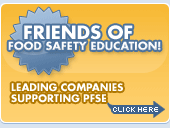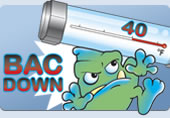|
Foodborne Illness: How to Keep From Getting Sick
"It must have been something I ate," is often the explanation for what many people call the "stomach flu". Scientists however, have a different name for this problem. They call it foodborne illness and estimate that each year 76 million cases of it strike people in the United States. But you don't have to be one of the unlucky ones. Most cases of foodborne illness can be prevented through some simple food handling and storage steps. All it takes is a little know-how and such everyday weapons as soap and water, a refrigerator and a food thermometer to check the temperature. What is a Foodborne Illness?
Foodborne illness is the sickness that results from eating foods that are contaminated with harmful bacteria and other microorganisms. Although you may not see, smell or taste these "bugs", under the right conditions, they may be present on the foods when they are purchased or get into food during preparation, cooking, serving or storage. Common symptoms of foodborne illness include diarrhea, abdominal cramps, fever, headache and vomiting. These symptoms may come on as early as a half hour after eating contaminated food or may not develop for up to two weeks. They usually last only a day or two, but in some cases can persist a week or more. For most healthy people, foodborne illnesses are neither long-lasting nor life-threatening. However, the consequences can be severe and may require hospitalization and even lead to death in the very young, the very old and those with weakened immune systems. How to Keep Foods Safe
Because bacteria can survive on raw foods despite aggressive controls at the processing and retail levels, food safety experts urge consumers to think about food safety at each step in the food handling process -- from shopping or bringing takeout foods home to storing leftovers. This means consumers should always follow these four simple steps: Clean -- Wash hands, utensils and surfaces with hot soapy water before and after food preparation, and especially after preparing meat, poultry, eggs or seafood to protect adequately against bacteria. Using a disinfectant cleaner or a mixture of bleach and water on surfaces and antibacterial soap on hands can provide some added protection. Separate -- Keep raw meat, poultry, eggs and seafood and their juices away from ready-to-eat foods; never place cooked food on an unwashed plate that previously held raw meat, poultry, eggs or seafood. Cook -- Cook food to the proper internal temperatures (this varies for different cuts and types of meat and poultry) and check for doneness with a food thermometer. Cook eggs until both the yolk and white are firm. Chill -- Refrigerate or freeze perishables, prepared food and leftovers within two hours and make sure the refrigerator is set at no higher than 40°F and that the freezer unit is set at 0°F. IN SHORT... FIGHT BAC!® |




















